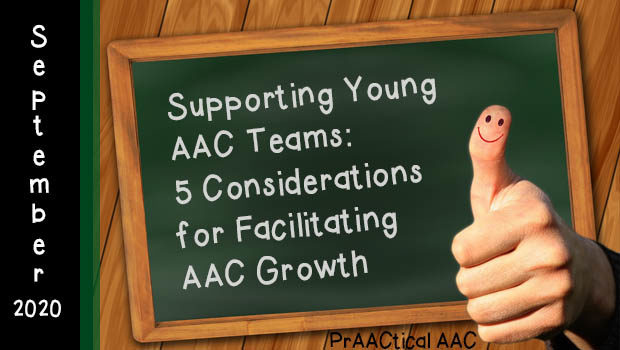Supporting Young AAC Teams: 5 Considerations for Facilitating Growth

We’ve all been there. An AAC user enters a new situation where the team is open to AAC but not very skilled. They are full of good intentions but their AAC knowledge and skills aren’t quite there yet. To be honest, they probably are somewhat wary of what we’re expecting them to do as it all seems so overwhelming. And in many cases, they’re also fearful of our judgment and worry about looking less than competent in front of others.
We’re eager to help them get up to speed so that they can provide the AAC supports that our communicators need in order to flourish. Our own AAC skills are strong but we may have constraints of a different type that threaten to undermine the success of this budding AAC team. For example, we often feel the pressure of time and hear the tick-tock of the clock as each second of missed opportunities drifts by. We may harbor resentment, disappointment, or suspicion based on previous experiences that were less than successful. These feelings, while legitimate and valid, have to be dealt with in ways that don’t impede the growth of the stakeholders whose AAC habits we hope to influence.
These young teams have a LOT of work to do in order to become adequate supporters of our AAC students and clients and must put in even more effort to become truly skilled. And, in most cases, they have to build these skills without sufficient time, energy, or resources. They may have been brought into this team without sufficient preparation or even against their will. Chances are, they are doing their best to appear confident, stay positive, and be open to change.
How can we bring these teams along so that our AAC users get the support they need?
Clearly, we need to bring information, training, coaching, and tangible resources to the table. And we have to do what we can so that they have the time needed for learning and skill-building. But that’s only part of the equation. The other part relates to their feelings of self-efficacy, confidence, and commitment to growth. Here are some suggestions for supporting that part of the equation.
- Take a long view: This will take time. With the right conditions, supports, and strategies, it generally takes teams about 6-8 weeks to begin showing signs of competence as AAC supporters. If there is a history of failure or conditions that undermine their confidence, it may take at least twice as long for those early signs of competence to emerge. And if your teams are coping with distance education or teletherapy, they will need additional time to learn how to make remote AAC support effective. The pressure to ‘hurry up and get it right’ is not likely to accelerate the process of becoming adequate AAC partners. We’re likely to be more effective by shielding young AAC teams from those sentiments so that the pressure to perform quickly doesn’t become a barrier to acquiring the skills and habits we hope to see in them over time.
- Manage your expectations: There will be lots of missteps. Mistakes will be made. Developing the ability to support AAC users is not seamless and there are lots of instances of ‘two steps forward and one step back.’ This is a natural part of the growth process so build that into your expectations and planning.
- Create an atmosphere that values growth: Suspend judgment. Reward risk-taking. Celebrate the baby steps. Think in terms of inch stones, not milestones.
- Develop relationships: Know your team, and do what you can to find solution strategies that meet each person where they live. Don’t be afraid to be vulnerable. AAC is challenging and it is perfectly okay to talk about your own mistakes and shortcomings in trying to create optimal learning experiences. We’re all a work in progress but to a beginner, the skills used by the more experienced team members may seem unattainable. Maybe you were trained in a strategy last year, but are still working to use it well and often. Voicing your own challenges can help to create an atmosphere where the motto is ‘we’re all in this together.’
- Be an authentic cheerleader: Be generous with praise and stingy with criticism. Shout out the good things you are seeing, even when you have to really stretch to find positive changes. There will be a time for critique and correction, but in the beginning, what they need the most is energy to keep trying. Use those ‘praise sandwiches,’ with two or three positive remarks coming before and after any suggested improvements. Help them see what they are doing well. Make it clear that YOU see and appreciate their progress. They may have miles to go, but unless they feel energized and supported, they may not have the staying power to make this AAC journey.
The pressure of doing it all, doing it right, and being under a microscope can cause young AAC teams to wither and decay. When accompanied by appropriate resources, training, and coaching, we can use these strategies to nurture them through their fragile beginnings so that they can grow and flourish.
Do you have tips or strategies for helping new AAC teams survive and flourish during those the first few months? We’d love to hear them.
Filed under: Featured Posts, PrAACtical Thinking
Tagged With: Teaming & Collaboration
This post was written by Carole Zangari



2 Comments
Thanks for all of the stellar reminders, Carole! As always, right on target.
Thank you, Dr. Binger. I think we sometimes underestimate the role of connection and belonging in this process, as well.